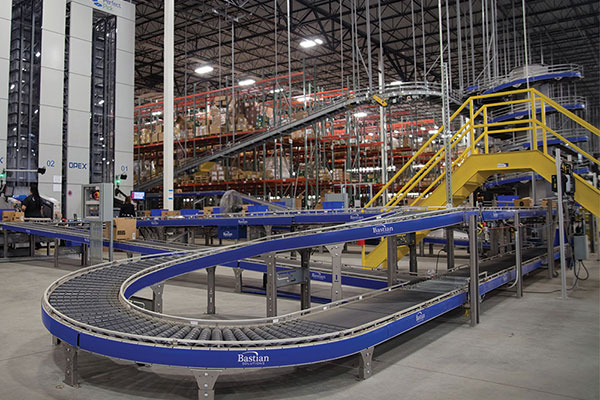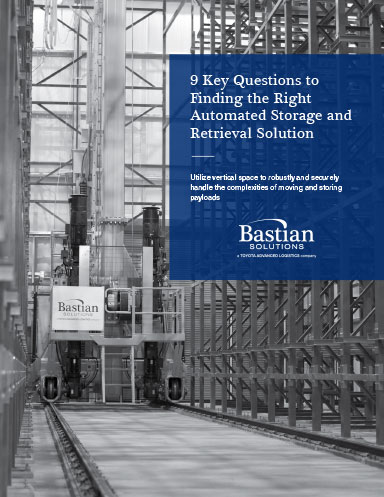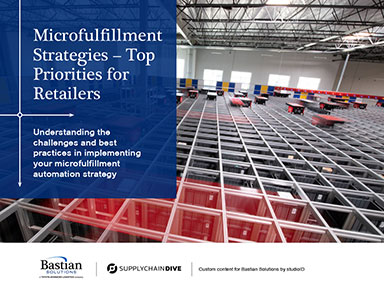4 DC Design Focus Areas: Beyond Automated Warehouse Technology
Streamlining the complex processes of getting products from inbound receiving to outbound truck loading requires thoughtful orchestration of functions within the four walls of distribution and fulfillment centers that extends beyond selecting the right automated technology.
4 Key Focus Areas
Planning the placement and flow of order picking, reverse logistics, product replenishment, product storage, receiving, order pack out, and, if applicable, value-added services leads to time savings, faster throughput, and accurate and on-time customer fulfillment.
Earlier this month we explored five common mistakes made in DC layout design and planning. Let’s take a look at five more areas that you’ll want to consider during the planning phase to unlock even more efficiency opportunities.
Technology Selection
Vertical Space – Usable space in a warehouse isn’t limited to the horizontal plane. Don’t forget to look up. Whether you are moving into a new warehouse or retrofitting an existing facility, examine available vertical space and install systems that can fully utilize it. For example, consider using mezzanines, goods-to-person systems, or AS/RS (automated storage and retrieval systems) in your DC design to maximize the use of vertical real estate. Any of these options will free up floor space for other operations, storage and walking paths.
Product Transport – As you evaluate available space and various configurations, conveyor systems are a popular product transport solution but consider a few points: conveyor is bolted to the floor, marking a permanent decision on material flow; if conveyable volume is low and non-conveyable volume is high, the operational impact will be less efficient than other solutions.
Remember, conveyor is not the only automated option to move products; AGVs and AMRs, for example, offer flexible and non-stationary solutions.
Piece Picking – Even though many SKUs do not have the cubic velocity for carton flow, warehouse operators often store them in carton flow rack anyway. The results: cases remain unused, gathering dust while full-length lanes are left underutilized.
An alternative option is to explore replacing carton flow with standard shelving bays, thus increasing pick density, decreasing time spent walking, and increasing productivity.
Location, Location, Location
Supervisor Office Locations – Many DC designs locate supervisor offices/cubes in the middle of the facility. Intuitively, this makes sense: supervisors are literally in the center of operations, so they should have a good understanding of operational problems/challenges.
In reality, however, this creates a false sense of security. Believing their location ensures that they are always informed, supervisors never leave their cube. A better strategy: locate supervisors outside of the operational layout. This will force them to leave their office and walk the system.
Building Location – Keep in mind that docks and doors should be as close to a corner of the real estate lot as possible in order to maximize expansion in the two opposite directions. Poor planning in the location of the facility can reduce expansion options.

Training
If you are adding new automation technology to your warehouse, more often that means reduced labor requirements and flexibility to redeploy labor resources to more valuable functions. In our experience, that means new tasks and responsibilities. Take the time to identify what additional training is needed to successfully redeploy those employees.
People are a critical component of any system, whether it is automated or not. Productivity gains are only achieved if employees and warehouse operators know how to run and manage the system. Take the time to train on all warehouse processes, including automation.
Automate for Transformation
Focusing on automating manual processes instead of automating for transformation frequently translates to minimized performance gains. Like the saying goes “don’t pave the cow path,” reminding us not to feel obligated to memorialize or enshrine an existing process if that process isn’t worth keeping.
For example, manual order fulfillment picking requires employees to walk through shelving aisles searching for and picking customer orders. Goods-to-person solutions, though, transform that process by eliminating the need for aisles and employee travel. Instead, the correct item is sourced by a robot and presented to the picker. The transformed process stores more in less space, eliminates employee travel, and reduces labor requirements.
Plan Effectively: Identify Opportunities to Optimize
Planning for a new distribution or fulfillment facility lends itself to plenty of opportunities for optimization and improvement. Taking the time to review key data points such as historical transactions, operational audits, strategic plans and growth forecasts are crucial to identifying a design and selecting automation technology that will be impactful to your business goals. Keep these four key focus areas and the five common mistakes to avoid in mind as you explore options.
Ready to talk about your solution? Bastian Solutions experts leverage real world experience from our more than 500 engineers to provide automation solution recommendations that are the right fit for your specific operations. Using a brand agnostic approach, our experts review risk assessments based on past projects to select the right technologies for the job.
Related White Papers
9 Key Questions to Finding the Right Automated Storage and Retrieval Solution
Designed for high volume movement of products in and out of storage, Automated Storage and Retrieval Systems (ASRS) are often employed to support manufacturing and distribution operations. Download Now!
Microfulfillment Strategies – Top Priorities for Retailers
Consumers’ buying patterns have changed the game for retailers - COVID has supercharged the demand for online shopping, same day or even within the hour delivery. Download Now!
Article Topics
Bastian Solutions News & Resources
Movu Robotics and Bastian Solutions partner to offer flexible robotics solutions GEODIS maximizes flexibility and minimizes touches Exotec adds Bastian Solutions as newest regional integrator in North America Depalletizing and palletizing gain in flexibility Bastian Solutions CB18 AGF: Smart, Efficient Manufacturing and Distribution Material Handling – no Operators Needed Bastian Solutions reveals automated guided forklift Bastian Solutions SmartPick™: Reimagine Order Fulfillment with Artificial Intelligence More Bastian SolutionsLatest in Warehouse|DC
Microsoft Unveils New AI Innovations For Warehouses Spotlight Startup: Cart.com is Reimagining Logistics Walmart and Swisslog Expand Partnership with New Texas Facility Taking Stock of Today’s Robotics Market and What the Future Holds U.S. Manufacturing Gains Momentum After Another Strong Month Biden Gives Samsung $6.4 Billion For Texas Semiconductor Plants Walmart Unleashes Autonomous Lift Trucks at Four High-Tech DCs More Warehouse|DC















